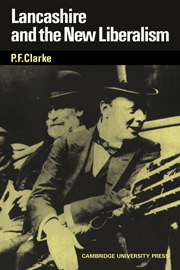Book contents
- Frontmatter
- Contents
- Preface
- Abbreviations
- Dedication
- PART ONE INTRODUCTION
- PART TWO FORMATIVE INFLUENCES
- PART THREE THE TERMS OF THE CONTEST
- 5 The pale of the Constitution
- 6 The politics of the street
- PART FOUR THE RECONSTITUTION OF LIBERAL LANCASHIRE
- PART FIVE FIELDS OF RECRUITMENT
- PART SIX GOING TO THE COUNTRY
- PART SEVEN CONCLUSION
- APPENDICES
- Bibliography
- Index
5 - The pale of the Constitution
Published online by Cambridge University Press: 23 November 2009
- Frontmatter
- Contents
- Preface
- Abbreviations
- Dedication
- PART ONE INTRODUCTION
- PART TWO FORMATIVE INFLUENCES
- PART THREE THE TERMS OF THE CONTEST
- 5 The pale of the Constitution
- 6 The politics of the street
- PART FOUR THE RECONSTITUTION OF LIBERAL LANCASHIRE
- PART FIVE FIELDS OF RECRUITMENT
- PART SIX GOING TO THE COUNTRY
- PART SEVEN CONCLUSION
- APPENDICES
- Bibliography
- Index
Summary
We have got now a democratic suffrage, but not so democratic as it ought to be – a suffrage which will not be truly democratic until we have not only abolished plural voting but we have got rid of many of the restrictions and technicalities which prevent access to the register from being as easy as it ought to be.
Asquith, December 1910After 1885 the checks upon democracy were more real than apparent. They were, however, effective enough to invalidate the imputation of a constituency's political representation to its general composition. For example, in 1911 Oldham elected a Conservative M.P. in a three-cornered by-election. Those who voted for him amounted to no more than 5.8 per cent of the population, and 21.5 per cent of the adult males. Although precise figures are only obtainable in Census years, it seems plain that in a three-cornered contest, like that at Manchester South West in January 1910, the winner had the support of about 17 per cent of the adult males; and even in a straight fight, like that at Walton in December 1910, F. E. Smith was elected by the votes of less than a quarter of the adult men in his division. In practice, then, household suffrage meant that the effective political decisions lay in the hands of the few rather than the many. Not that there was any shortage of franchises. In the counties there were three main ways of becoming enfranchised by reason of ownership, plus one through lease-holding; in both counties and boroughs there were franchises for ten-pound occupiers, inhabitant householders and lodgers; and in the boroughs there were certain reserved rights, the most important being those of freemen.
- Type
- Chapter
- Information
- Lancashire and the New Liberalism , pp. 103 - 129Publisher: Cambridge University PressPrint publication year: 1971



